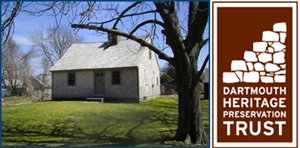AH12
 We finished excavating this unit last week, but (thanks to a volunteer who also volunteers at the Massachusetts Archaeological Society museum) we have new information on an important artifact found here! A small flake of what's known as Pennsylvania jasper was recovered from soils a little over a foot below the current ground surface, at the interface between topsoil and subsoil levels. This small stone artifact was made by "flaking," striking or pressing a stone in order to remove thin flakes. Pennsylvania jasper was widely traded in New England during prehistoric times. This flake's reddish color probably results from heating. It may have been burned when the property was cleared before the house was built. This small artifact is a material token of the long Native American history in Dartmouth and on the Akin House property. Dartmouth is located within traditional homelands of the Wampanoag people.
We finished excavating this unit last week, but (thanks to a volunteer who also volunteers at the Massachusetts Archaeological Society museum) we have new information on an important artifact found here! A small flake of what's known as Pennsylvania jasper was recovered from soils a little over a foot below the current ground surface, at the interface between topsoil and subsoil levels. This small stone artifact was made by "flaking," striking or pressing a stone in order to remove thin flakes. Pennsylvania jasper was widely traded in New England during prehistoric times. This flake's reddish color probably results from heating. It may have been burned when the property was cleared before the house was built. This small artifact is a material token of the long Native American history in Dartmouth and on the Akin House property. Dartmouth is located within traditional homelands of the Wampanoag people.AH13
We finished taking out the 20th-century trash level in AH13. AH10 sampled this feature last year and, even though the units are next to each other, different sorts of artifacts were found! Compared with AH10, the midden in AH13 yielded much less shell, animal bone, and slag and more burned glass and ceramic fragments. We hope to match some of the tableware to known patterns in order to see what sorts of things tenants at the Akin House were using in the middle decades of the 20th century. There was a compact brown topsoil under the midden with many fewer artifacts in it. We ended the week by digging into the transition between topsoil and subsoil. All topsoils in this yard area date from the 20th century, which suggests either that there was almost no earlier activity in this yard area (unlikely), or that the earlier topsoils were removed at some point, perhaps to flatten this yard area for use as a garden or work space, or for construction of a nearby shed.
AH16
We continued excavating in AH16. This unit, behind a 20th-century shed, had three dressed granite blocks visible at its surface. We expected these blocks to mark some sort of feature, such as a privy, well, or trash pit; but whatever they were from was only superficial. Soils below the rocks had few artifacts and no indication that anyone dug or built here before the 20th-century. While we were hoping to find an earlier feature, we have gained important information about the history of this portion of the yard. This information will help site stewards plan for the future.
AH17&18
 These two units are located adjacent to the northern house foundation, where an old cellar entrance was filled in. As discussed in last week's post, we're digging in this place because we'd like to know when this change happened. The fill in AH18 did not have any artifacts in it, although the layers above it did. They will help us figure out when the filling occurred. We did, in fact, find an earlier land surface in AH18: what I believe was the ground level when the land was cleared and the house was built! This level is marked by black charcoal and reddened subsoil, evidence of burning. You can clearly see this black level, and the orange level underneath, in this profile of AH18's southern wall. The rocks just above the black line may be part of the original cellar entrance. Because we wanted more information about the cellar entrance fill, we began unit AH17: a 1/4 sized unit that is adjacent to AH18 and actually within the entrance fill itself.
These two units are located adjacent to the northern house foundation, where an old cellar entrance was filled in. As discussed in last week's post, we're digging in this place because we'd like to know when this change happened. The fill in AH18 did not have any artifacts in it, although the layers above it did. They will help us figure out when the filling occurred. We did, in fact, find an earlier land surface in AH18: what I believe was the ground level when the land was cleared and the house was built! This level is marked by black charcoal and reddened subsoil, evidence of burning. You can clearly see this black level, and the orange level underneath, in this profile of AH18's southern wall. The rocks just above the black line may be part of the original cellar entrance. Because we wanted more information about the cellar entrance fill, we began unit AH17: a 1/4 sized unit that is adjacent to AH18 and actually within the entrance fill itself.



